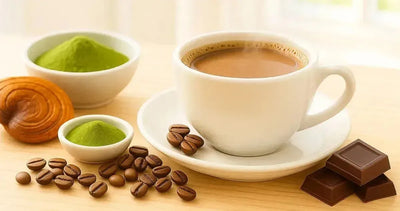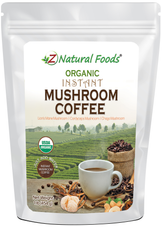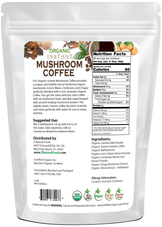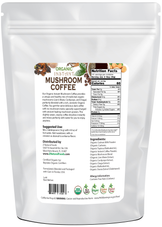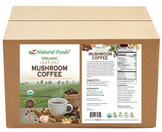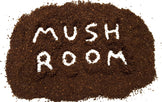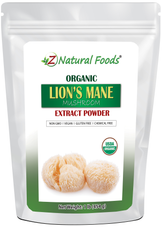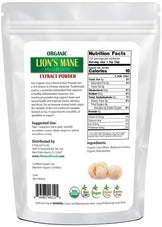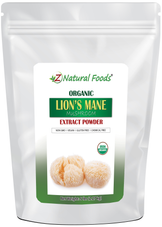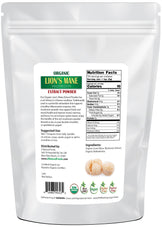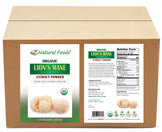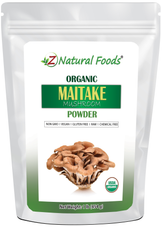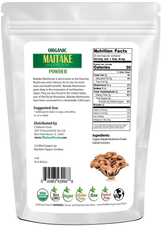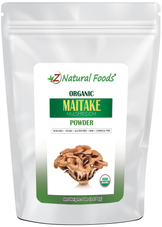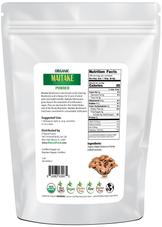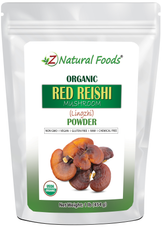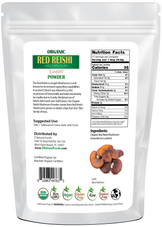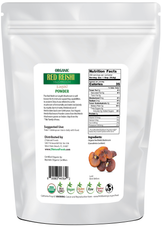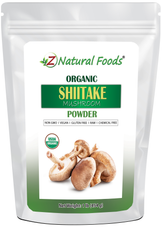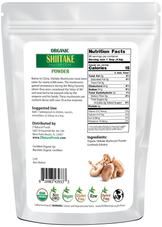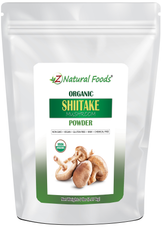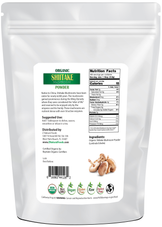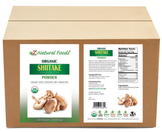Description
Description
If you have ever wondered what makes mushrooms so incredibly powerful, you have found the right article.
In this article, we explain what polysaccharides are, what they do, and what types of polysaccharides are in mushrooms.
What types of polysaccharides are in mushrooms?
It is believed that the primary polysaccharides found in mushrooms are beta-D-glucans. Other types of polysaccharides found in mushrooms are Alpha-glucans like glycogen, dextran, pullulan, and starch.
To answer this question about the types of polysaccharides in mushrooms correctly, it is vital first to understand what exactly polysaccharides are.
Let's get started.
All about the types of polysaccharides in mushrooms
In simple terms, polysaccharides are large carbohydrate molecules containing many small sugar molecules (monosaccharides) bonded by a glycosidic linkage (a type of bond that joins a carbohydrate molecule to another group).
Polysaccharides are the most abundant carbohydrate found in food.
They consist of more than ten monosaccharide units linked together. Polysaccharides form when monosaccharides and disaccharides link together (resulting from a dehydration process). The sugars participating in this bond are called residues.
Mushrooms contain a wide range of non-starch polysaccharides (carbohydrate fractions excluding starch and free sugar) like chitin, beta-glucans, alpha-glucans, hemicellulose, mannans, xylans, and galactans.
- Non-starch polysaccharides are distinguished into soluble and insoluble fractions, with up to 90% being insoluble fractions.
- Most (around 80%) insoluble polysaccharides are chitin, including beta-glucans bound onto chitin or protein.
It is believed that the primary polysaccharides found in fungi are beta-D-glucans which come in various forms (beta 1-3 and 1-6) and are specific to fungi and yeast.
Other forms of polysaccharides found in mushrooms are Alpha-glucans like glycogen, dextran, pullulan, and starch, which are not thought to provide the same nourishing qualities as beta-glucans.
This belief tells you only part of the story and may be based on flawed science.
You may have noticed that most medicinal mushroom product labels focus on only beta-glucan levels; therefore, some important points must be clarified.
Here are six accurate facts about beta-glucans:
- Beta-glucans are a classification of compounds known as polymers.
- There are hundreds of beta-glucan shapes and sizes, and while some are biologically active, others are not. Furthermore, not all are immunologically active.
- Each species of fungi may contain a different beta-glucan.
- Beta-glucans can differ in function, solubility, and interaction with other molecules.
- While beta-glucan are potent compounds, they are just one variable of a wide range of compounds responsible for a mushroom's many nourishing qualities.
- Ultimately, Beta-glucan levels are not necessarily the telltale sign of a product's effectiveness.
It is misleading to state that beta-glucan levels are the determining factor in the effectiveness of a mushroom product.
Beta-glucans are most effective when they work with all other constituents found in mushrooms, and if one or more are missing, it can change how effectively the end product works.
For example, a study discussing the polysaccharide K from turkey tail mushrooms showed that when lipase was applied, it reduced the immunological response of PSK by 80%.
This shows the importance of the associated lipids bound to the beta-glucans and that just their independent presence of them is not enough to obtain maximal benefits.
Bioactivity and mushroom preparation
It is widely agreed upon that to get the most nourishment out of your mushrooms, they should be:
- cooked,
- heat treated, and, or
- extracted.
Raw mushrooms are considered largely indigestible due to their rigid cell walls composed of chitin. It is also common that raw mushrooms have pathogens and toxins. These toxins are heat sensitive and potentially killed when heated. Alternatively, when eaten raw, exposure to these toxins can potentially cause harm.
Properly heating and preparing the mushrooms softens the fungal tissue, allowing access to all the nourishing compounds.
An article showing the effect of different drying methods on mushrooms showed that the physicochemical and antioxidant properties greatly differed for each technique.
In another article discussing the influence of heat on antioxidant and polyphenolic compound activity on shiitake mushrooms, it was concluded that the action of the antioxidant and polyphenolic compounds increased as preparation of time and temperature increased.
What does polysaccharide do to your body?
Polysaccharides can support a wide range of actions in the human body.
They have been shown to have immunological, neurogenic, cardiovascular, and microbiome effects and a host of other nourishing qualities.
For example, Lion’s Mane mushrooms contain many bioactive compounds like:
- Polysaccharides,
- Polypeptides,
- Prebiotic fiber,
- Hericenones, and
- Erinacines.
Some of these bioactive compounds have been linked to neurogenesis (growth and development of nerve tissue) because preliminary research on Lion’s Mane suggests its potential to support this process by possibly preventing and repairing nerve damage.
Hericenones and Erinacines have been shown to cross the blood-brain barrier, potentially stimulating nerve growth factor – A protein that plays a role in the maintenance, survival, and regeneration of neurons – which benefits those at high risk for brain injury.
In a small double-blind, placebo-controlled human study understanding the effects Lion’s Mane mushrooms have on mild cognitive impairment, “At weeks 8, 12 and 16 of the trial, the Yamabushitake group showed significantly increased scores on the cognitive function scale compared with the placebo group. The Yamabushitake group's scores increased with the duration of intake, but at week 4, after the termination of the 16 weeks of intake, the scores decreased significantly. Laboratory tests showed no adverse effect of Yamabushitake. The results obtained in this study suggest that Yamabushitake is effective in improving mild cognitive impairment.”
Another example is shiitake mushrooms, which are world-famous for tonifying Qi and blood and supporting Wei Qi (a healthy immune system response); Shiitake also dissolves phlegm and humidity and dispels wind. In Chinese Medicine, the wind is considered the spearhead of all illnesses because it catalyzes undesirable influences on the body.
A four-week parallel-group study with 52 healthy males and females between the ages of 21-41 consumed five or ten grams of mushrooms daily to determine if eating mushrooms can improve human immune function.
The results stated, “Eating L. edodes for four weeks resulted in increased ex vivo proliferation of γδ-T (60% more, p < 0.0001) and NK-T (2-fold more, p < 0.0001) cells. Both cell types demonstrated a greater ability to express activation receptors, suggesting that consuming mushrooms improved cell effector function. The increase in sIgA (secretory immunoglobulin mucus secretions) implied improved gut immunity. The reduction in CRP suggested lower inflammation.”
Fungi and the Microbiome
The human gut microbiome contains more than ten trillion microorganisms with more than 1000 species of known bacteria.
Prebiotics are identified based on the composition of their fiber content.
For example, chicory root is 65% fiber, Jerusalem artichoke is 32% fiber, and raw garlic is 17% fiber. Mushrooms are considered a potential source of prebiotics because they contain polysaccharides like chitin, mannans, glucans, galactans, and xylans.
They work by possibly increasing microbial diversity by stimulating local inflammatory response and producing catecholamines and metabolites, thereby changing gut flora composition.
In a study discussing the effects of turkey tail mushroom and amoxicillin on the gut microbiome of healthy individuals, it was concluded that the ingestion of the polysaccharopeptide PSP led to consistent microbiome changes. Therefore, it was shown that PSP from turkey tail mushrooms acts as a prebiotic.
Finally, in a study discussing reishi mushrooms' effects on gut microbiota in relation to obesity, it was concluded that reishi mushrooms could reduce obesity in mice via modulating gut bacteria.
In conclusion, edible choice medicinal mushrooms are some of the most revered and well-respected foods of the herbal tonic world, with a rich history going back thousands of years in both Eastern and Western medicine.
Therefore, our mission is to answer your questions and provide a thorough explanation and the critical details necessary to understand this fun and important topic.
For more information about our mushrooms, visit these great resources:
- What are the three main parts of a mushroom?
- What is Maitake Mushroom used for? (+5 traditional uses)
- Which Mushroom Is Good For The Brain? (Explained)
- Most nutritious mushrooms (list of 7)
To review all of our mushroom products, go here:


